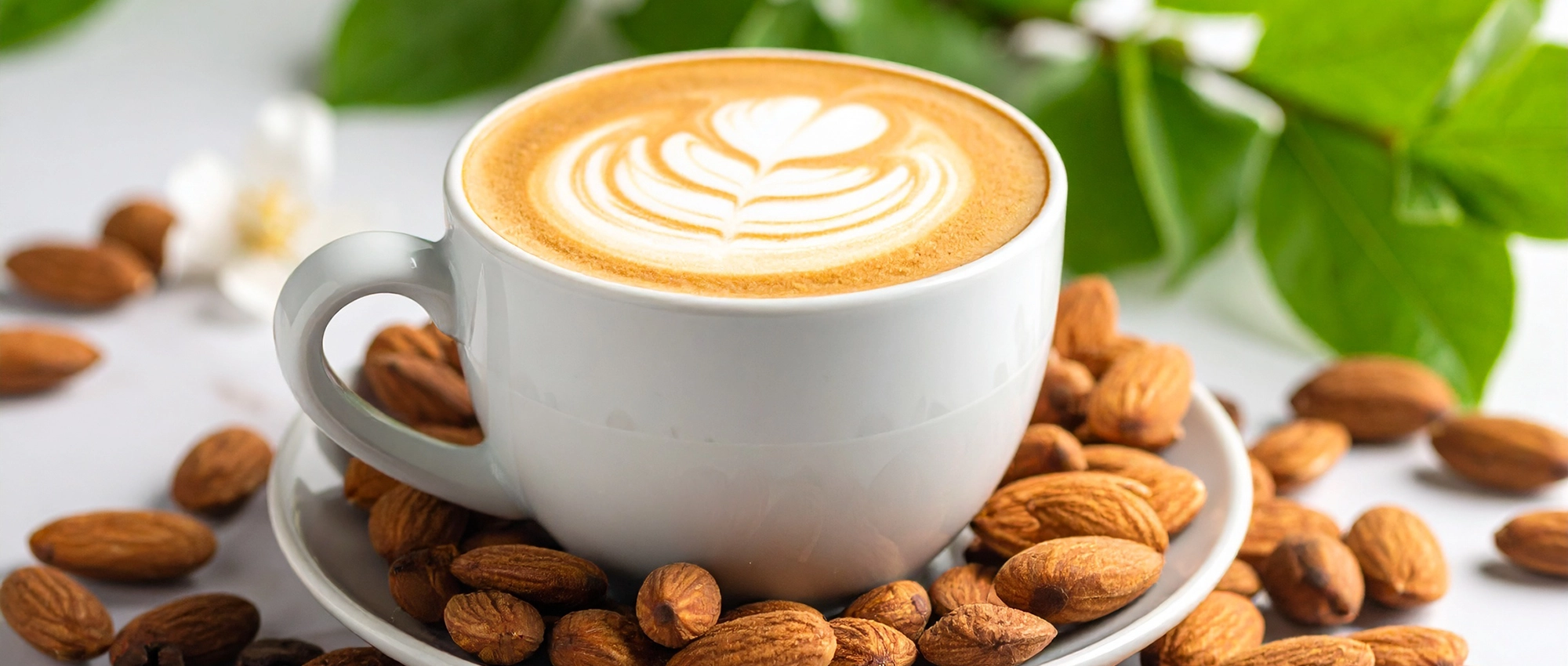Plant-Based Milk Guide | Coffee Shop Operations & Profitability

Plant-Based Milk Guide | Coffee Shop Operations & Profitability
The plant-based milk revolution has fundamentally transformed coffee shop operations across the globe. What began as a niche request from health-conscious customers has evolved into a mainstream expectation that significantly impacts every aspect of coffee business operations, from inventory management and equipment requirements to pricing strategies and profit margins. Understanding how to successfully navigate this shift is crucial for modern coffee shop success.
The Plant-Based Milk Market Explosion
The plant-based milk market has experienced unprecedented growth, with sales reaching $2.8 billion in 2023 and projected to exceed $4.5 billion by 2028. This growth isn’t just a passing trend, it represents a fundamental shift in consumer preferences driven by health consciousness, environmental concerns, lactose intolerance awareness, and dietary restrictions.
Coffee shops have become the primary battleground for plant-based milk adoption. Unlike grocery store purchases, coffee shop visits allow customers to experiment with different alternatives without committing to full containers, making cafes the perfect testing ground for new plant-based options. This dynamic has created both opportunities and challenges for coffee shop operators.
Modern consumers expect choices. A recent industry survey found that 78% of coffee shop customers have tried plant-based milk in their coffee, and 45% regularly order plant-based alternatives. For many customers, the availability of quality plant-based options influences their choice of coffee shop, making this a competitive necessity rather than a luxury offering.
Popular Plant-Based Milk Alternatives and Their Characteristics
Oat Milk: The Barista’s Choice
Oat milk has emerged as the dominant plant-based alternative in coffee shops due to its superior steaming properties and creamy texture. Its natural sweetness complements coffee flavors without overpowering them, and its protein and fiber content creates stable micro-foam that rivals dairy milk performance.
Operational Considerations:
- Excellent steaming and latte art capabilities
- Shelf stability varies by brand (7-10 days after opening)
- Higher cost than most alternatives but premium pricing acceptance
- Some separation occurs, requiring gentle stirring before use
Almond Milk: The Pioneer Alternative
As the first widely adopted plant-based milk, almond milk maintains strong customer loyalty despite steaming challenges. Its light, nutty flavor appeals to customers seeking subtle taste enhancement without heaviness.
Operational Considerations:
- Steaming requires lower temperatures and gentler technique
- Prone to separation and curdling in acidic coffee
- Longer shelf life than oat milk (10-14 days after opening)
- Most cost-effective plant-based option for budget-conscious operations
Soy Milk: The Protein Powerhouse
Soy milk offers the highest protein content among plant-based alternatives, creating good texture and nutritional value. However, its stronger flavor profile and occasional curdling issues have reduced its popularity compared to newer alternatives.
Operational Considerations:
- Requires careful temperature control to prevent curdling
- Some customers have soy allergies or preferences against soy
- Good steaming properties when handled properly
- Moderate pricing and decent shelf stability
Coconut Milk: The Tropical Option
Coconut milk provides rich, tropical flavor that works particularly well in flavored coffee drinks and cold beverages. Its higher fat content creates creamy texture but can be overwhelming in traditional espresso drinks.
Operational Considerations:
- Excellent for flavored drinks and cold brew applications
- May solidify in cold temperatures, requiring warming before use
- Strong flavor profile limits versatility
- Premium pricing due to processing costs
Emerging Alternatives
New plant-based options continue entering the market, including pea milk, hemp milk, rice milk, and various blends. While these represent smaller market segments, staying informed about emerging options helps position your coffee shop as innovative and responsive to customer needs.
Cost Analysis and Profitability Impact
Direct Cost Comparisons
Plant-based milk alternatives typically cost 2-4 times more than conventional dairy milk, creating significant impact on beverage cost structures. Here’s a typical cost breakdown per 8-ounce serving:
Dairy milk: $0.35-$0.45 Oat milk: $0.65-$0.85 Almond milk: $0.55-$0.70 Soy milk: $0.50-$0.65 Coconut milk: $0.70-$0.90
These cost differences translate directly to reduced profit margins unless offset by premium pricing strategies. A typical 16-ounce latte with plant-based milk costs $0.40-$0.80 more to produce than the same drink with dairy milk.
Premium Pricing Strategies
Most successful coffee shops implement premium pricing for plant-based alternatives, typically charging $0.50-$1.25 extra per drink. This pricing strategy helps offset higher ingredient costs while signaling quality and specialty positioning.
Pricing Considerations:
- Customer willingness to pay premiums varies by location and demographic
- Bundling strategies can reduce price resistance
- Seasonal promotions help introduce customers to plant-based options
- Clear value communication justifies premium pricing
Volume Economics
Higher volume operations can negotiate better pricing with suppliers and achieve economies of scale. Coffee shops serving 200+ drinks daily often secure 15-25% better pricing on plant-based alternatives compared to smaller operations.
Volume Strategies:
- Group purchasing with other local businesses
- Direct relationships with plant-based milk producers
- Private label opportunities for high-volume operators
Storage and Inventory Management Challenges
Refrigeration Requirements
Plant-based milk alternatives have varying refrigeration needs and shelf lives, complicating inventory management. Unlike dairy milk’s consistent 7-day refrigerated shelf life, plant-based alternatives range from 5-14 days after opening, depending on the product and brand.
Storage Best Practices:
- First-in, first-out rotation systems prevent waste
- Temperature monitoring ensures product quality
- Clear labeling with opening dates tracks freshness
Shelf Life Variability
Different plant-based milks have dramatically different shelf lives, requiring sophisticated inventory tracking. Coconut milk may last 5-7 days after opening, while some almond milks maintain quality for 10-14 days. This variability requires staff training and systematic inventory management.
Inventory Optimization:
- Demand forecasting based on historical usage patterns
- Multiple supplier relationships ensure consistent availability
- Emergency backup plans for supply disruptions
- Waste tracking identifies optimization opportunities
Seasonal Demand Fluctuations
Plant-based milk demand often fluctuates seasonally, with higher consumption during health-conscious periods (January, pre-summer months) and lower demand during traditional comfort food seasons. Understanding these patterns helps optimize inventory levels and reduce waste.
Equipment Modifications and Steaming Techniques
Steam Wand Adjustments
Different plant-based milks require modified steaming techniques to achieve optimal texture and temperature. Oat milk steams similarly to dairy milk but at slightly lower temperatures, while almond milk requires gentler heating to prevent separation.
Technical Considerations:
- Temperature control becomes more critical with plant-based alternatives
- Steam wand cleaning frequency may need to increase
- Different milks may require different steaming pitcher sizes
- Staff training on proper techniques prevents waste and improves quality
Equipment Maintenance
Plant-based milks can affect equipment differently than dairy milk. Some alternatives may cause more buildup in steam systems, while others might require more frequent cleaning cycles. Understanding these impacts helps prevent equipment issues and maintains drink quality.
Maintenance Adaptations:
- Modified cleaning schedules accommodate different residue patterns
- pH monitoring ensures equipment longevity
- Preventive maintenance programs address plant-based milk impacts
- Staff training on equipment care with alternative milks
Customer Demand Patterns and Preferences
Demographic Insights
Plant-based milk preferences vary significantly across customer demographics. Younger customers (18-35) show highest adoption rates, while customers over 50 demonstrate lower but growing interest. Urban locations typically see 40-60% higher plant-based milk requests than suburban or rural areas.
Customer Segmentation:
- Health-conscious customers prioritize nutritional benefits
- Environmentally motivated customers focus on sustainability
- Lactose-intolerant customers need reliable, consistent options
- Flavor-focused customers experiment with different alternatives
Seasonal and Time-of-Day Variations
Plant-based milk consumption patterns often differ from dairy milk patterns. Morning rush hours may see higher oat milk demand, while afternoon customers might prefer lighter almond milk options. Understanding these patterns helps optimize inventory and staffing.
Demand Pattern Analysis:
- Morning commuters often prefer quick-steaming oat milk
- Afternoon customers may choose lighter almond or coconut options
- Weekend customers show higher experimentation rates
- Seasonal health trends influence demand spikes
Menu Integration Strategies
Beverage Menu Adaptation
Successfully integrating plant-based alternatives requires thoughtful menu design that highlights options without overwhelming customers. Clear labeling, taste descriptions, and staff recommendations help customers navigate choices confidently.
Menu Design Principles:
- Clear plant-based option identification
- Taste profile descriptions help customer selection
- Recommended pairings guide customer choices
- Seasonal specials showcase plant-based versatility
Signature Drink Development
Creating signature drinks that showcase plant-based alternatives can differentiate your coffee shop and drive customer loyalty. Oat milk’s sweetness works well in caramel-based drinks, while coconut milk excels in tropical or spiced beverages.
Innovation Opportunities:
- Seasonal drinks highlighting specific plant-based milks
- Cold brew combinations using plant-based alternatives
- Specialty latte art possible with well-steaming plant-based options
- Health-focused beverages emphasizing nutritional benefits
Cross-Selling Opportunities
Plant-based milk customers often align with health-conscious purchasing patterns, creating opportunities for complementary sales of organic pastries, protein additions, or wellness-focused food items.
Staff Training and Customer Education
Barista Skill Development
Plant-based milk alternatives require different handling techniques, steaming methods, and storage protocols. Comprehensive staff training ensures consistent quality and reduces waste while improving customer satisfaction.
Training Components:
- Proper steaming techniques for each alternative
- Storage and rotation procedures
- Customer education talking points
- Troubleshooting common issues
Customer Communication
Educating customers about plant-based options, their characteristics, and best applications helps build loyalty and reduces order confusion. Knowledgeable staff can guide customers to options that match their preferences and dietary needs.
Communication Strategies:
- Taste profile explanations help customer selection
- Nutritional information addresses health-conscious customers
- Environmental impact information appeals to sustainability-focused customers
- Honest recommendations build trust and satisfaction
Marketing and Competitive Positioning
Brand Differentiation
Plant-based milk offerings can serve as significant brand differentiators, particularly in competitive markets. Progressive positioning around health, sustainability, and inclusivity appeals to growing customer segments.
Positioning Strategies:
- Health and wellness focus attracts nutrition-conscious customers
- Environmental messaging appeals to sustainability-minded consumers
- Inclusivity positioning welcomes customers with dietary restrictions
- Innovation leadership demonstrates market responsiveness
Social Media and Digital Marketing
Plant-based beverages often photograph well and generate social media engagement, creating organic marketing opportunities. Highlighting beautiful latte art made with plant-based alternatives or seasonal plant-based specials can drive customer acquisition.
Digital Marketing Tactics:
- Instagram-worthy drink photography showcases plant-based options
- Educational content builds customer knowledge and loyalty
- User-generated content campaigns encourage customer engagement
- Influencer partnerships can expand reach to target demographics
Future Trends and Preparation Strategies
Emerging Technologies
New plant-based milk technologies continue developing, including improved protein content, better steaming properties, and enhanced nutritional profiles. Staying informed about innovations helps position your coffee shop for future trends.
Technology Developments:
- Protein-enhanced plant-based alternatives improve nutritional profiles
- Improved steaming formulations enhance barista performance
- Sustainable packaging innovations reduce environmental impact
- Direct-trade relationships with plant-based milk producers
Market Evolution Predictions
Industry experts predict continued growth in plant-based alternatives, with increasing focus on taste, functionality, and sustainability. Coffee shops that establish strong plant-based programs now will be better positioned for future market evolution.
Preparation Strategies:
- Building relationships with innovative suppliers
- Staff training programs that adapt to new products
- Customer feedback systems guide product selection
- Financial planning accommodates changing cost structures
Implementation Roadmap for Coffee Shops
Phase 1: Market Research and Planning
Before implementing plant-based alternatives, conduct thorough market research to understand your customer base, competitive landscape, and operational requirements. This foundation ensures successful program launch and sustainable operations.
Research Components:
- Customer surveys identify demand and preferences
- Competitive analysis reveals market positioning opportunities
- Supplier research identifies reliable partners
- Cost analysis determines pricing strategies
Phase 2: Product Selection and Testing
Choose plant-based alternatives based on customer preferences, operational requirements, and financial considerations. Start with one or two options and expand based on demand and operational capacity.
Selection Criteria:
- Steaming performance affects drink quality
- Shelf life impacts inventory management
- Customer acceptance influences sales volume
- Cost structure determines profitability
Phase 3: Staff Training and Operational Integration
Comprehensive staff training ensures successful plant-based alternative implementation. Cover technical skills, customer communication, and operational procedures to maintain quality and efficiency.
Training Focus Areas:
- Technical steaming and handling skills
- Customer education and recommendation abilities
- Inventory management and rotation procedures
- Troubleshooting and quality control
Phase 4: Marketing Launch and Customer Education
Successful plant-based alternative programs require customer education and marketing support. Communicate options clearly, highlight benefits, and provide staff with talking points to support customer adoption.
Launch Strategies:
- Soft launch with regular customers for feedback
- Staff training on customer education
- Marketing materials highlighting new options
- Promotional pricing or sampling to encourage trial
Conclusion
Plant-based milk alternatives represent both significant opportunity and operational challenge for modern coffee shops. Success requires understanding customer demands, managing increased operational complexity, and implementing pricing strategies that maintain profitability while meeting customer expectations.
The coffee shops that thrive in this new landscape will be those that embrace plant-based alternatives as a competitive advantage rather than viewing them as an operational burden. By focusing on quality, education, and customer service, coffee shops can turn plant-based milk offerings into profit centers that attract new customers and build loyalty among existing ones.
The key to success lies in viewing plant-based alternatives not as a trend to weather, but as a permanent shift in customer expectations that requires thoughtful integration into every aspect of coffee shop operations. From inventory management and staff training to pricing strategies and marketing positioning, plant-based alternatives touch every element of successful coffee shop management.
Coffee shops that invest in understanding their customers’ plant-based preferences, train their staff thoroughly, and implement operational systems that support quality and consistency will find themselves well-positioned for continued growth in an increasingly diverse and demanding marketplace. The plant-based revolution isn’t coming to coffee shops; it’s already here, and the most successful operators are those who embrace it fully while maintaining the quality and profitability that sustain their businesses long-term.
Gary Downey
Gary Downey
Tags :
Coffee U Sunday: Weekly Coffee Business Education
Get expert coffee insights delivered to your inbox every Sunday. Equipment guides, brewing tips, business strategies, and industry trends to help your business succeed.
Categories
Categories
- Coffee Brewers (1)
- Coffee Business Success (9)
- Coffee Grinders (1)
- Coffee Shop Owners (8)
- Coffee Technology (3)
- Cold Brew Coffee (2)
- Espresso Machines (8)
- Espresso Shots (3)
- La Marzocco (2)
- Maintenance & Service (2)
- Specialty Coffee Drinks (3)
- Water Treatment (1)
📚 Equipment Guides
Comprehensive breakdowns of different machine types, helping you make informed purchasing decisions
 Maintenance Tips
Maintenance Tips
Professional techniques to keep your equipment running at peak performance and extend its lifespan
 Brewing Science
Brewing Science
Understand the ‘why’ behind extraction, temperature stability, and equipment design
 Troubleshooting Help
Troubleshooting Help
Common problems and solutions to minimize downtime and service calls
 Business Insights
Business Insights
ROI calculations, workflow optimization, and equipment selection for your specific needs
 Technology Explained
Technology Explained
Demystifying features like PID control, pressure profiling, and heat exchange systems
Coffee U Sunday: Weekly Coffee Business Education
Get expert coffee insights delivered to your inbox every Sunday. Equipment guides, brewing tips, business strategies, and industry trends to help your business succeed.
Share
Use our search function or browse by category to find exactly what you need. Can’t find an answer? Contact us directly, your question might inspire our next Coffee U article! As we grow, so will this resource, shaped by the real needs of coffee professionals like you.
Start exploring Coffee U today and discover why Bean & Brew Technologies is committed to elevating the coffee industry through education and exceptional service.
Have a question?
We're here to help.









